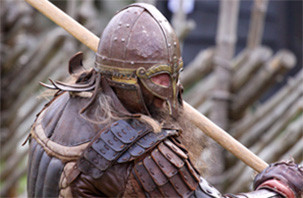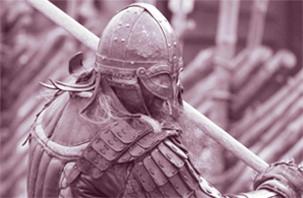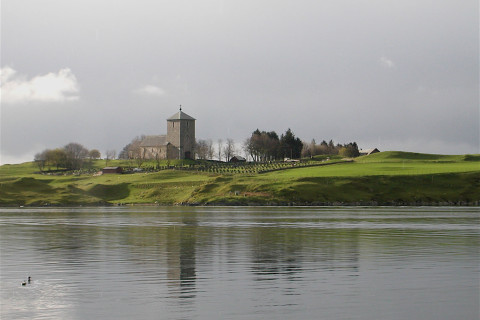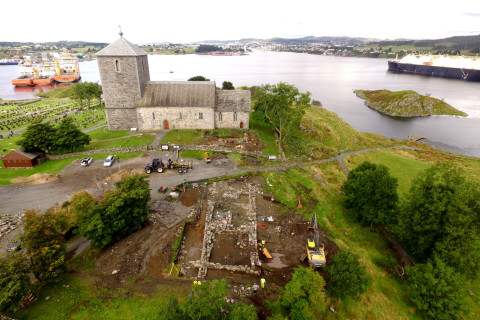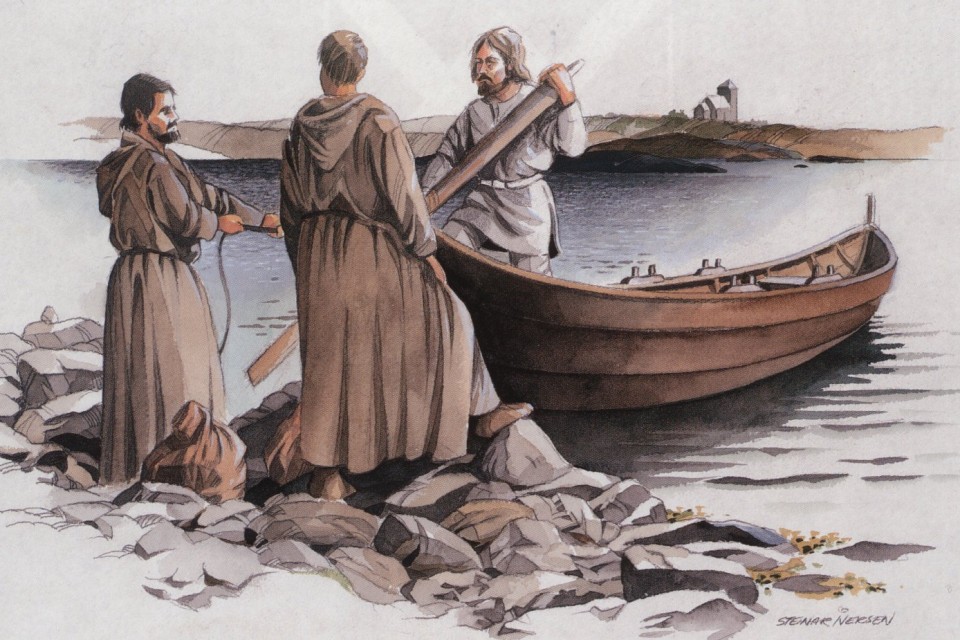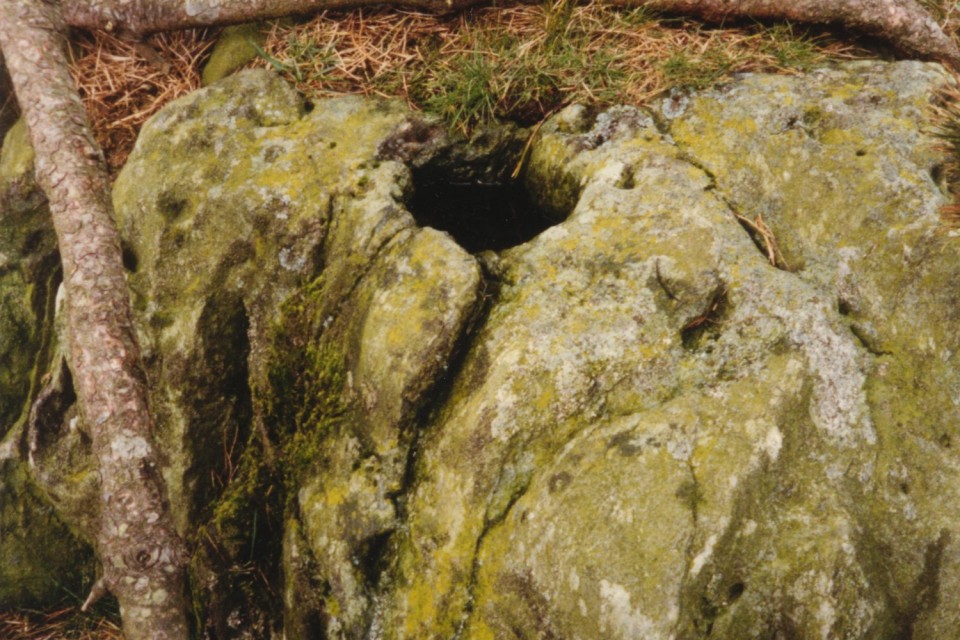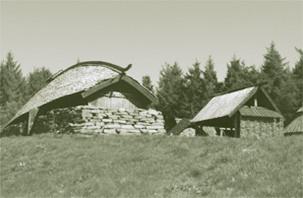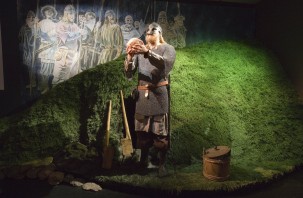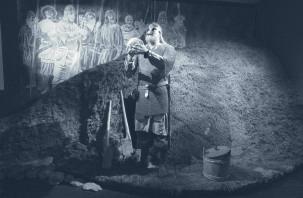Legends about St. Olaf
Text: Marit Synnøve Vea

ST OLAF’S CHURCH. Many pilgrims visited St. Olaf’s church. The pilgrims used the door that faced northwards. Today this door is bricked up. (Photo Ørjan Iversen)
After King Olaf Haraldsson was killed in 1030, miracles began to happen around the dead king, sick people were healed and Olaf’s hair and nails grew as if he were alive. The king was declared to be a saint and many pilgrims visited his burial place in Nidaros.
Håkon Håkonsson consecrated his church at Avaldsnes to St. Olaf, and the church became an important stopping place for pilgrims going to Nidaros. Adam of Bremen (ca. 1070) tells that most of these pilgrims travelled by sea, and many of them came to Avaldsnes.
On the north side of the church we can see a bricked up door. This was the pilgrims’ entrance, as they always had to enter any church with their backs to the north – because they believed evil heathen forces remained up north. Snorri’s Edda tells “Niðr ok norðr liggr helvegr” = “Down and north is the road to hell”. Even today we find this in the phrase “to judge someone north and down.”
There are still place names and tales from North Karmøy which remind us of this pilgrim traffic.
SALHUS FROM SÆLEHUS (ON SÁLUHUS)
The king’s farm manager at Avaldsnes built a sælehus, – a hostel to house pilgrims and other travellers- where the strait Karmsund is at its narrowest. This place is still called Salhus (salu = soul).

PILGRIMS’ ROUTES IN THE AVALDSNES AREA (Ill Dag Frognes)
Many travellers came to the royal estate at Avaldsnes, and the most prominent of these were welcomed to overnight at the royal manor. The Sælehus was probably erected for the poor. In 1368 the hanseatic traders set fire to the Sælehus, at
Other well-known place names in the area that reminds us of the pilgrims are:
Feginsbrekkå, (= “happy slope” )the first place where the pilgrims that took the land route, could see St.Olaf’s church.
Monkaskar (= the monks’ pass) and Munkhaug (= the monks’ hill). Pilgrims often wore a cloak that made people compare them with monks, hence the name.
SAINT OLAF AND THE TROLL SIGGE
There are several legends related to the standing stone “Virgin Mary’s Sewing needle”. (See Virgin Mary’s Sewing Needle). One of them is about Saint Olaf and the troll or giant Sigge:
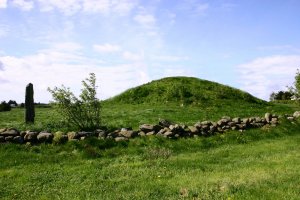
THE PRINCE MOUND AT BLOOD HEIGHTS. (Photo Ørjan Iversen)
Saint Olaf wanted to build a stone church with a tower on his royal farm at Avaldsnes. But the king had little time to do this himself because he was so busy travelling around the country Christianizing people. Therefore the King made a pact with a giant or a troll who had residence inside one of the ancient burial mounds up on Blood Heights.
The agreement was that the troll should build the church, and if he managed to finish it within a certain time, he should be rewarded with the sun, the moon or the King’s soul.
The troll started to work, and such underground beings build with magic, much quicker than a Christian man can imagine. The last day before the deadline expired, Saint Olaf became really anxious. It seemed that the troll would complete his task by the deadline and what should the king do? Not even kings can bring down the sun and the moon. How could Olaf save his soul?

St Olaf’s well at Torvastad. Foto Marit S. Vea
In the evening the king rode up on Blood Heights (where the battle between Håkon the Good and the sons of Eirik Bloodaxe once stood). One of these burial mounds is called “Prinsahaugen”. From within this mound Olaf heard a child crying. He stopped his horse and listened. Then he heard a woman singing:
Silence, silence little child
your father Sigge will arrive
with the sun and moon to his baby.
Now, Saint Olaf knew what the troll was called; Sigge. The King was saved. Because everyone knows that if a Christian man mentions the troll by name, the troll will turn to stone. The King rode back to the church and hid up to the church wall. When the troll should put the last stone on the church tower, Olaf cried out: “Beware now, Sigge, the last stone will fall down.”
In that moment the troll cracked. He turned to stone and fell headlong into the soil north of the church. There he is still standing and bear witness that good will defeat evil, just like the King defeated the troll.

“ST. OLAF’S WELL”
St Olaf has stabbed his fist in the rock to get hold of water for his men. Since then this source has never run dry. (Ill. Svein Johannessen)
The legend goes on to tell that judgment day comes upon us when the top of the stone touches the church wall. Hence, from far back in time the priests at Avaldsnes have looked after the stone. In dark winter nights, they have climbed up, knocking bits off the top every time he has been dangerously near the church wall. And by doing this, they have saved the world from destruction. Yes, some believe that the priests at Avaldsnes still are doing this.
THE WELL OF ST. OLAF
“The Well of St. Olaf” at Karmøy was once a well-known place for pilgrims.
The legend claims that King Olaf was followed by enemies through the strait Karmsund. He sailed his ship to the western side of the island. From here the King and his men started to drag the ship over land from Torvastad to Vikingstad.
The hard work made them thirsty and the King stabbed his clenched fist in the rock. Immediately it came roaring up clear water so everyone could drink.
This well never runs dry and many people have witnessed the healing power of the water which is supposed to be especially good when it comes to curing eye diseases. Pilgrims who drank the water used to put small crosses of wood or straw nearby the well.

PILGRIM JARS FROM NORTHERN KARMØY
Several pilgrim jars are found in northern Karmøy. When the pilgrims had filled their jars with holy water, they sealed them with wax. Perhaps it was some pilgrims who had been at St. Olaf’s well who lost these jars?
Another version of this legend claims that Olaf’s ship cut right through the hills and made the valley you can see today. Where it glided forward, the sea followed.
St. Olaf’s well is located in Torvastad but a few hundred meters to the west we find Hovland. As the name suggests, it can have been a pagan hov (temple) here. We know that water played a major role in Norse mythology, and perhaps the water in St. Olaf’s well also had a sacred function in Pre-Christian times.
ST OLAF AND “THE FIVE FOOLISH VIRGINS”
Opposite Salhus, on the other side of the strait Karmsundet, you can see a star shaped cluster of five standing stones. This is a burial place from the Late Roman Period, with the grave in the middle. (ca. 300 AD).
These stones are called The Five Foolish Virgins and the legend that connects them to St. Olaf tells us how they got this name:
Saint Olaf frequently travelled around the country and Christianized people. One time he had been up north, and he was sailing his ship back to the royal estate at Avaldsnes. When he passed the narrowest point of the strait Karmsundet, he saw five haughty girls standing on the mainland side and waved at him. The King, however, didn’t allow himself to be tempted. Instead he cried out: “Now, stand there and turn to stone, until I come back again”.
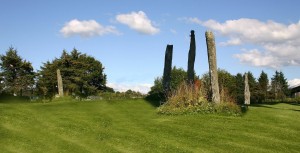
FIVE FOOLISH VIRGINS. A star shaped burial site from about AD 300. This cluster of stones is standing under Karmsund bridge, where the strait Karmsund is at the very narrowest. (Photo Ørjan Iversen)
Immediately the virgins turned to stones. They are still standing there, looking over the strait Karmsund against St. Olaf’s church, waiting for the King to return.
Tradition also claims that this star shaped cluster of stones is part of a religious / magical calendar system.
WHEN OLAF’S SHIP SANK
“The legend says that Saint Olaf anchored his ship at the Vikingstad Sea, by Saksedne. Then he went from there up to Avaldsnes, the King’s farm. When Olaf returned to Saksedne, the ship had sunk. My father told me that once he found a ship there. He put the anchor in the ribs, but as he started to drag, the anchor-claw straightened out. Later he couldn’t find it again. It was by Uredne the ship lay. “
(Narrated by Ivar Vikingstad (b. 1896). The father of Ivar was named Jørgen Vikingstad (b. 1858).This story has been passed on to Marit S. Vea by Evy Vikingstad, North Karmøy Historical Society)

Pilgrimage to St Olaf’s well during St Olaf’s Festival (Olavsdagene) at Avaldsnes. (Photo Palmer Vistnes)
ST OLAF’S FESTIVAL (OLAVSDAGENE)
St Olaf’s Festival at Avaldsnes takes place each year around Olsok (“Olaf’s Wake”- 29th of July). Regular features in the Festival are: Pilgrimage, concerts, service St. Olaf church and seminars.
THE COASTAL PILGRIM ROUTE (KYSTPILEGRIMSLEIA)
Avaldsnes is one of four Regional Pilgrim Centre along the Coastal Pilegrim Route. The others are in Bergen, Selje and Smøla. In addition, there are 22 Key Places along the coast from Rogaland to Trøndelag. The Regional Pilgrim Centre at Avaldsnes will help and support pilgrims and others involved in pilgrimage traffic in Rogaland. The Key Places in Rogaland where pilgrims can receive stamps in their pilgrim passports are Egersund, Obrestad, Stavanger, Utstein and Avaldsnes.
Read more about The Coastal Pilgrim Route
Back
